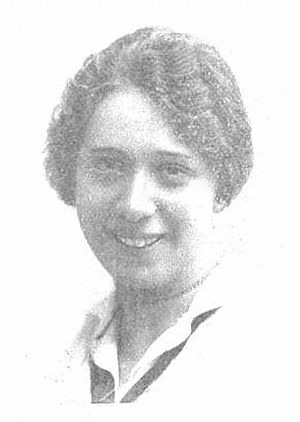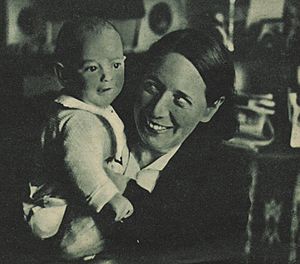Margarita Nelken facts for kids
Quick facts for kids
Margarita Nelken Mansberger
|
|
|---|---|
 |
|
| Born |
Margarita Nelken
07.05.1894 |
| Died | 05.03.1968 (aged 73) |
| Nationality | Spanish |
| Occupation | Art critics, writer |
Margarita Nelken (born July 5, 1894 – died March 5, 1968) was an important Spanish writer and a champion for women's rights. She was a well-known thinker and a key person in the first women's movements in Spain during the 1930s.
Contents
Margarita Nelken: Early Life and Education
Margarita Nelken was born in Madrid, Spain, in 1894. Her full name was María Teresa Lea Nelken y Mansberger. Her parents were from Germany and were Jewish. They owned a jewelry store.
Margarita was a very talented student. She learned music, painting, and several languages. Besides her native Spanish, she could speak French, German, and English. Her sister, Carmen Eva Nelken, also became famous as an actress and writer.
Margarita Nelken's Career and Ideas
Margarita Nelken wrote many books in the 1920s. These books often talked about social and political issues. One of her books was called La trampa del arenal (The Sand Trap), published in 1923.
She also wrote about the lives of women in Spain. Her books included La condición social de la mujer en España (The Social Condition of Women in Spain, 1922). She also wrote about women writers and women politicians in Spain. Margarita believed strongly that women workers were being treated unfairly. She argued that this unfair treatment hurt both men and women in society.
Margarita Nelken's Political Journey
In 1931, Margarita Nelken joined the Spanish Socialist Workers' Party (PSOE). This was a political party that aimed to improve the lives of working people. She ran for a seat in the Spanish Parliament in October 1931 and won. She was elected again in 1933 and 1936.
Even though she fought for women's rights, Margarita had a complex view on women voting. At one point, she felt that Spanish women were not yet ready to vote. She believed they might be too influenced by traditional ideas.
Margarita was a strong supporter of land reform, which meant changing how land was owned and used. Because of her background and her strong views on women's rights, some people on the right side of politics criticized her.
After a big workers' strike in Asturias in 1934, Margarita was accused of being involved in a rebellion. She had to leave Spain for a while. During her time away, she lived in Paris, France. She also visited countries like Sweden and the Soviet Union. She worked to raise money to help people who were affected by the government's actions after the strike.
Margarita returned to Spain in 1936. When the Spanish Civil War began, she stayed in Madrid. She played an important role in protecting valuable artworks. She helped move artistic treasures from Toledo to a safe vault in the Bank of Spain. She also gave speeches on the radio to encourage soldiers and citizens. Later, she became unhappy with the leaders of the Socialist Party. She then left the PSOE and joined the Communist Party (PCE).
Margarita Nelken's Exile and Later Life
Margarita Nelken continued to serve in Parliament until 1939. When the Spanish Civil War ended, she and her sister had to leave Spain. They went to Mexico because they were on the losing side of the war.
In Mexico, Margarita continued her work as an art critic, writing about art. She also wrote a book called Los judíos en la cultura hispánica (Jews in Hispanic Culture). This book was republished in Spain in 2009. Margarita Nelken passed away in Mexico City on March 5, 1968, at the age of 73.
See also
 In Spanish: Margarita Nelken para niños
In Spanish: Margarita Nelken para niños


